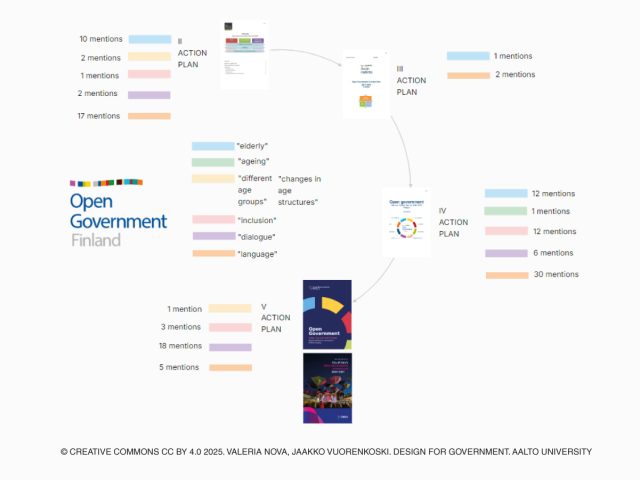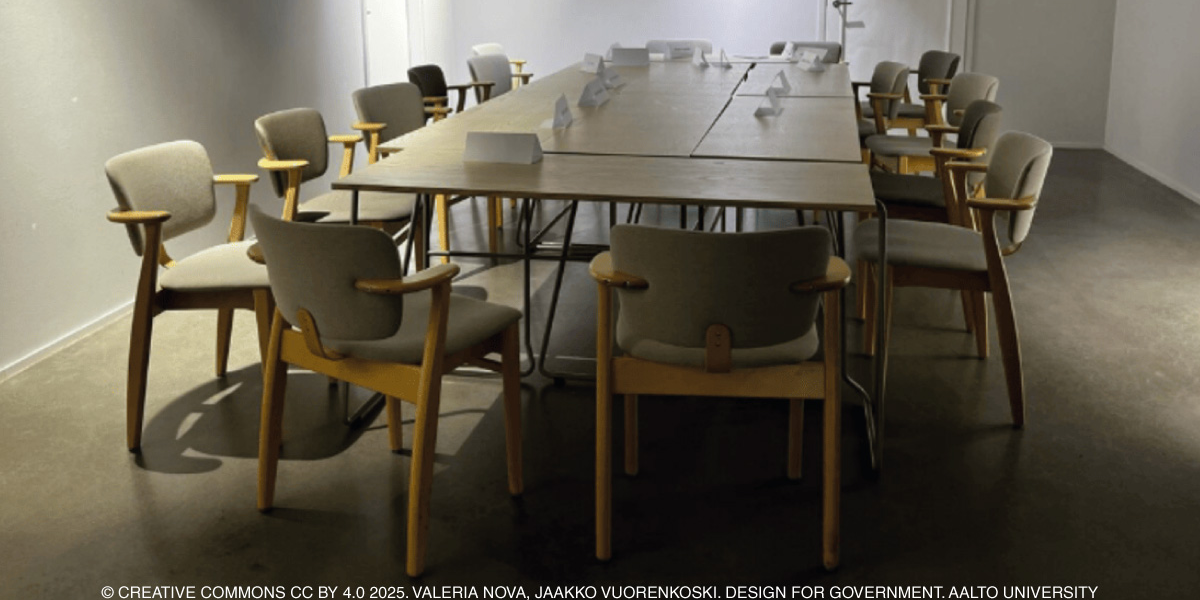This blog post reports on work-in-progress within the DfG course! The post is written by the ‘Action Plan and elderly inclusion in Finland’ workstream dealing with the Ministry of Finance’s brief on ‘Open Governance for an Age-Friendly Finland’. The workstream includes Jaakko Vuorenkoski from Information and Service Management program (Aalto BIZ) and Valeria Nova from Creative Sustainability program (Aalto ARTS).
Written by: Valeria Michel Nova Cázares
As we started the course in Design for the Government at the end of February, the first two weeks were crucial to setting up the foundations of our research. Currently, our workstream is responsible for analyzing the Open Government Action Plan 2023–2027 through a critical lens focusing on elderly inclusion in governance and their participation in civic life. Through desk research and preparation for an upcoming roundtable discussion with project partners from the Ministry of Finance and the Elderly Citizens Council, we aim to gain a conceptual approach to understanding the phenomena at hand and identify potential opportunities.
During this time, Marco Steinberg and Núria Solsona, instructors for the course, highlighted two elements that set the baseline of our learning journey: First, to engage effectively at the governmental level, we must learn to speak their language. Second, in this course, we are not going to change the world but rather influence others to work towards a better future. These statements became clearer as we delved into group work.
Unraveling abstraction for setting up a common understanding

Figure 1: Keywords analysis of the Action Plans II – V
When we approached the V Action Plan of Open Government, several questions naturally arose: How should we approach the document? What mindset is required? We reminded ourselves that, at this stage, we are not seeking solutions but aiming for curiosity and understanding. This mindset would help us avoid frustration and focus on getting familiar with the levels of abstraction often found in policy documents. We began by analyzing the style and structure of the Action Plan, clarifying terminology, defining our research questions and identifying gaps while distinguishing between what we could know based on current resources and what required further investigation.
Statements from Jan-Erik Johansson (guest lecturer for the course) on the overview of the Finnish government highlighted how transparency has been a core value in promoting trust and fostering a citizen-centric approach, which are simultaneously key elements of Open Government. Still, an existing tension between administrative goals and citizens’ needs demonstrates the current gaps particularly affecting the elderly population such as struggles between efficiency and accessibility in service delivery.
“How to satisfy both administrative goals and citizens’ needs?”
—Jan-Erik Johansson’s, Prof. Administrative Science, Tampere University, Finland
Influencing others to work towards a common agenda
The concept of “influence” resonated with us during our approximation to the Action Plan and our group work. Reflecting on how the course encouraged us to consider our role in influencing change, mirrored the Finnish Constitution’s emphasis on citizen participation which entails Democracy as the right of the individual to participate in and influence the development of society and his or her living conditions (Ministry of Finance, 2019) However, challenges persist in how Finns perceive their role in open governance.
“Finns have strong trust in government. However, according to the OECD trust in one’s own abilities to participate and whether it has influence is clearly lower among Finns than in the reference countries.” (Open Government. Action Plan 2023-2027 Finland, n.d.)
While the Open Government initiative focuses on encouraging civic participation, its actual impact remains unclear. Although some initiatives such as National Dialogues, have accomplished increasing civic engagement, the government has not systematically measured to what extent public authorities at the local, regional, and national levels have used input from dialogues in their work (Finland Action Plan Review 2023-2027 – Open Government Partnership, 2024) Examining how influence is reflected within the Action Plan’s development may offer insight into the mechanisms that ensure citizen’s voices can effectively contribute in decision-making.
How is influence reflected in the Action Plan’s development and implementation?
According to the Open Government Partnership (OGP), action plans are central to a member country’s participation. They are the product of a co-creation process in which government and civil society define ambitious commitments to foster transparency, accountability and inclusion (Action Plan Cycle – Open Government Partnership, 2024). “Influence” in this context flows vertically, from international frameworks that set the baseline for the 75 countries in their jurisdiction, and horizontally, through the collaborative approach with several stakeholders at the municipal level.
Additionally, upstream and downstream synergies translate high-level language—present in Action Plan commitments— into practical implementation strategies through input (Democratic processes), throughputs (Administrative Structures) and output structures (Public services delivery).
How do our findings and group dynamics influence our projects?
Our collaborative structure —from the gigagroup (as one big group focusing on the elderly), to the supergroup (dividing the group between Care and Open Government), and down to workstreams (where four subgroups address specific topics)—demonstrates how our research findings influence others while reinforcing a systemic approach.
This became particularly evident in the preparations for the roundtable, where gaps in our understanding were filled with insights from other groups and vice versa. Aligning these matters also helped us to identify common gaps and select high-level questions to guide strategic conversations that may lead to identifying the first entry points signs.
On the other hand, our research revealed that the V Action Plan does not make explicit mention of the elderly, prompting us to review previous action plans and raise new questions: To what extent do successes and failures of previous Open Government Action Plans influence the upcoming plans? And how are the elderly, as a growing demographic and highly active voters, considered?
Setting up in analog mode
Finally, preparing to work in the governmental arena for the roundatable required more than just decoding abstraction in terms of language, it also involved reducing noise by creating an environment to engage in clear and open communication. By avoiding digital distractions, considering room arrangements, and designing an appropriate agenda, we re-learned how to engage in an analog mode. Additionally, understanding our interlocutors, the project partners—who they are, what they do, and how to facilitate a discussion that is both useful for our research and comfortable for them—will be essential for keeping engagement and flow during the roundtable discussion.
References:
Action Plan Cycle – Open Government Partnership. (2024, August 12). Open Government Partnership. https://www.opengovpartnership.org/process/action-plan-cycle/
Finland Action Plan Review 2023-2027 – Open Government Partnership. (2024, March 28). Open Government Partnership. https://www.opengovpartnership.org/documents/finland-action-plan-review-2023-2027/
Ministry of Finance. (2019). Policy brief: An overview of open government work and development in Finland. https://vm.fi/documents/10623/307541/Policy_Brief_5_2019_Open_Government.pdf/8b338d6a-0483-3cd7-4d94-7e7845fc4d6a/Policy_Brief_5_2019_Open_Government.pdf
Open Government. Action Plan 2023-2027 Finland. (n.d.). In Open Government Finland. Retrieved February 28, 2025, from https://avoinhallinto.fi/wp-content/uploads/2024/09/Action-plan_Open-Gov-Finland_2023-2027.pdf
The DfG course runs for 14 weeks each spring – the 2025 course has now started and runs from 24th Feb to 27th May. It’s an advanced studio course in which students work in multidisciplinary teams to address project briefs commissioned by governmental ministries in Finland. The course proceeds through the spring as a series of teaching modules in which various research and design methods are applied to address the project briefs. Blog posts are written by student groups, in which they share news, experiences and insights from within the course activities and their project development. More information here about the DfG 2025 project briefs. Hold the date for the public finale on Tuesday 27th May!

